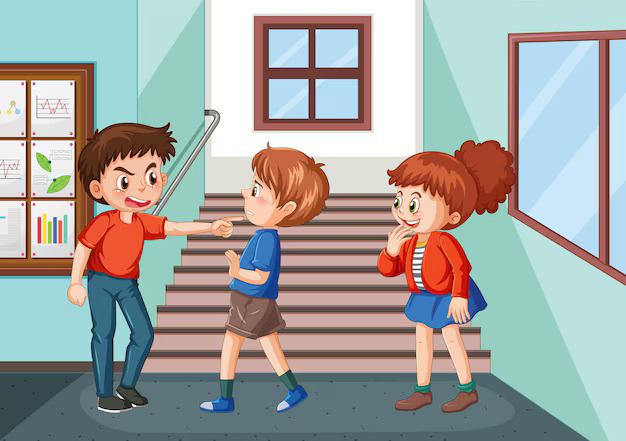When Kids Fighting at School, it’s important to address the situation promptly and calmly. School fights can happen for various reasons, such as disagreements or misunderstandings. Teachers and staff should intervene immediately to ensure everyone’s safety and to understand what led to the conflict. By teaching conflict resolution skills and promoting respect among students, schools can create a safer and more supportive environment where conflicts are resolved peacefully.
How do parents help Kids Fighting at School?
Parents play a crucial role in supporting their children when they are involved in Kids Fighting at School. First and foremost, it’s important for parents to create an open and supportive environment where their child feels safe to discuss what happened without fear of judgment. Listening actively and empathetically to their child’s perspective can provide insights into the reasons behind the altercation.
How to Handle Kids Fighting at School?
When dealing with incidents like Kids Fighting at School consulting “Teen counselling” is invaluable. These experts provide a supportive environment where children can express themselves and explore the underlying causes of their actions.
-
Stay Calm: Approach the situation calmly to assess what happened and ensure everyone’s safety.
-
Listen: Hear out both sides of the story to understand the context and reasons behind the behavior.
-
Impose Consequences: Implement appropriate consequences for fighting or rude behavior, such as loss of privileges or extra chores.
-
Talk with Your Child: Discuss the incident calmly and help them understand the consequences of their actions.
-
Teach Conflict Resolution: Provide guidance on peaceful ways to resolve conflicts without resorting to physical or verbal aggression.
-
Encourage Empathy: Help your child understand how their actions affect others and encourage empathy towards peers.
-
Meet with Teachers or Counselors: Collaborate with school staff to understand any underlying issues and develop a plan for improvement.
-
Monitor Behavior: Keep track of your child’s behavior at school and communicate regularly with teachers to monitor progress.
-
Implement School Interventions: Support any interventions or strategies recommended by the school to address behavior concerns.
-
Consult Child Therapists: If behavior issues persist or are severe, consider seeking support from child therapists or counselors.
-
Behavioral Assessment: Get a professional assessment to understand potential underlying issues affecting your child’s behavior.
-
Family Counseling: Family counseling can help improve communication and support positive behavioral changes.
-
Promote Positive Activities: Encourage your child to participate in constructive activities that promote positive behavior and self-control.
-
Set Clear Expectations: Establish clear rules and expectations for behavior at home and school, with consistent consequences for both.
-
Celebrate Progress: Recognize and celebrate improvements in behavior and conflict resolution skills.
Dealing with your Kids Fighting at School can be challenging, but a “Online counsellor” can offer expert advice and strategies. Counselors also guide parents in setting consistent boundaries and supporting their child’s social and emotional development.
Exploring the Impact of Peer Pressure on Kids Fighting at School?
Peer pressure can significantly influence Kids Fighting at School, impacting their behavior and social dynamics in several ways:
-
Conformity: Children may feel pressured to conform to peer expectations, including engaging in aggressive behaviors to gain acceptance or avoid rejection.
-
Desire for Status: Peer pressure can encourage kids to seek social status or dominance within their peer group, leading to conflicts over perceived hierarchy.
-
Lack of Conflict Resolution Skills: Kids influenced by peer pressure may lack the skills to resolve conflicts peacefully, resorting to physical aggression as a means of asserting themselves.
-
Emotional Regulation: Pressure from peers can heighten emotional responses, making it difficult for children to manage anger or frustration without escalating into fights.
-
Fear of Exclusion: Fear of being ostracized or bullied by peers can motivate children to participate in fights to protect their social standing.
-
Role Modeling: Children may imitate aggressive behaviors they observe in peers, believing it is a normative way to handle disputes.
-
Peer Group Norms: Group dynamics and norms within peer circles can influence children to conform to behaviors that may include aggression as a means of resolving conflicts.
-
Approval Seeking: Kids may engage in fights to seek approval or validation from peers, especially in environments where aggression is normalized.
-
Insecurity and Self-esteem: Pressure from peers can exacerbate feelings of insecurity or low self-esteem, leading children to act out aggressively to assert themselves.
-
External Validation: Children may perceive engaging in fights as a way to gain recognition or admiration from peers, reinforcing the behavior through positive reinforcement.
-
Risk-taking Behavior: Peer pressure can encourage risk-taking behavior, including engaging in physical altercations, as a way to demonstrate bravery or toughness.
-
Group Polarization: Peer pressure within groups can amplify behaviors, creating a cycle where aggressive actions are reinforced and normalized.
-
Social Media Influence: Online peer pressure through social media platforms can exacerbate conflicts by magnifying public perceptions and interactions.
-
School Environment: The social climate and culture within the school can influence how peer pressure manifests, impacting the frequency and intensity of fights among students.
In conclusion, addressing and supporting children involved in fighting at school requires a collaborative effort between parents, educators, and the child themselves.










